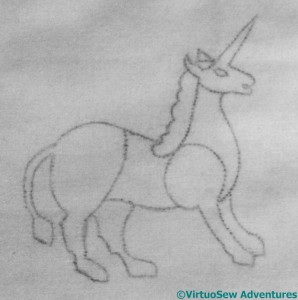
The Unicorn
I enjoyed working Rusty and Spots in the Opus Anglicanum Stitchalong so much I decided I wanted to do some more laid and couched work.
I rummaged around in my heraldry books and online for medieval unicorns (for a quadruped) and swans (for something winged), and produced something of a synthesis. Some of the medieval unicorns had leopard feet, and one of them had a curly, piggy tail. Mine has vaguely leopardly feet, and a lion’s tail. I’ve sized him so that he fills the same space as did Spots.
It occurred to me that I may want to work medieval creatures in the corners of the Vision of Placidus, when I get that far. I was going to use Rusty, Spots, and their friends, but then I realised that in that context, it would be more appropriate to the story of conversion to use the symbols of the Evangelists – the winged ox, ram, man, and eagle.
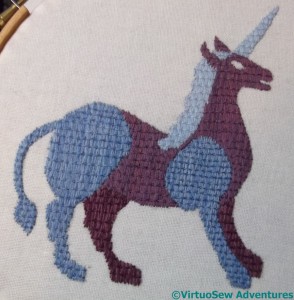
Unicorn – the first layer
So I’m still not sure what I will do with these present creatures when they are done..
Since I am using existing stores here, and I wasn’t sure I would have enough of the colours I used for Rusty and Spots, I moved on to a different colour range – purples and blues. These aren’t the slightly fluffy Appleons wools I used for the other two, but are rather smoother, softer version.
Again, I’m stretching out the colours by threading two colours in the needle for the underlayer. And my goodness, doesn’t it grow quickly!

Silver Crest
Last month, I had made several unsatisfactory trials with silver thread, and took my headaches to the Harrogate Knitting and Stitching Show to ask advice on the Golden Hinde stand.
I got to the show with about 40 minutes to go of the Thursday evening late opening, which meant that the aisles were relatively clear and I could actually talk to Sarah. After some discussion, we came up with a very bright and blingy silver Jap. In fact it’s so bright and blingy as to be verging on mirrored, and I was surprised at quite how calm it looked when I finished it.
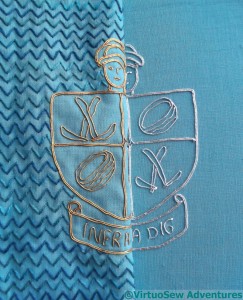
Crests Together
The reason it is so bright is that the metallic wrapping film is much broader than it was on any of the other silver threads I tried. That carries its’ own penalty, because turning corners becomes trickier – and indeed, in a few cases, rather untidier (click on the picture to enlarge it and look at a few of the corners!). I found that I had to devise new pathways for the couching, and use more short lengths. This panel is markedly more fluffy on the back than the gold one was!
I just have miles of that cloud filling stitch variation to do now (and, of course, choose and apply the braided edging!). The background stitching will help to throw the silver crest into relief. I have laid the completed gold over the silver so that you can see. With decent lighting, it should have enough personality to hold its corner.
If it doesn’t, I will frame it up as a separate panel, and show people just how difficult it was!
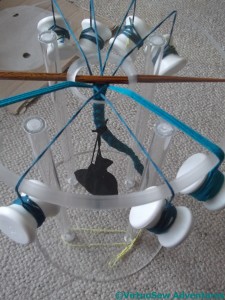
Marudai
I’ve been fascinated by Kumihimo braiding for ages. I first heard about it many years ago from a mathematician friend of my husband’s. Quite why, I can’t now recall, unless it was a desperate attempt on the part of the mathematician to find something textile-related to talk to me about.
Jolly decent of him, don’t you think? He certainly had no idea what he was starting..
Anyway, I’ve heard a lot about it, and rather like the effects that can be obtained. In the UK, the best source for information and equipment is Jacquie Carey at The Carey Company. Jacquie has also become better known to historical embroiderers because while she was researching historical braids she became fascinated by the stitches in them, and besides her books on Braiding, she has now written books about Elizabethan Stitches (remember my experiments with some of them for the Glittering Nightcap?), and Sweet Bags!
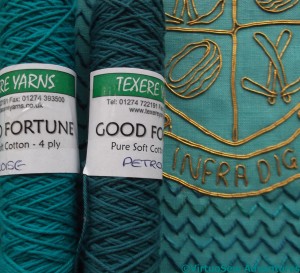
Threads And Crest

Braid Experiments
I’ve bought myself an acrylic marudai and bobbins, and spent a fascinating – not to say, bewildering! – couple of hours at Texere Yarns in Bradford, trying to find some suitable yarns to experiment with.
Since my initial aim is to create a braid edging for the Crest for the Dig, I began by finding some cotton knitting yarns that seem to go very nicely with the panels, as well as a whole load of extra yarns for additional experiments.
Then I started playing…!
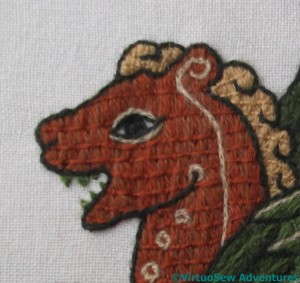
Got My Eye On You…!
Under Rusty’s very bright and beady eye, I got started on the companion that Tanya provided for him in the Stitchalong on her blog, Opus Anglicanum.
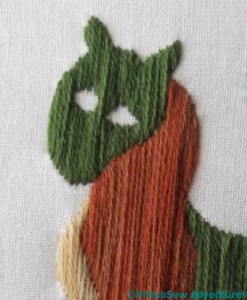
Detail Of Underlayer
Which turned out to be a Leopard!
This closeup of his head and neck gives you a chance to see the two different shades used side by side in the underlayer of the laid and couched work.
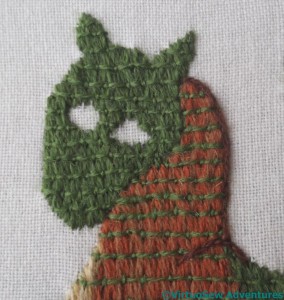
False Start
Once I’d finished the couching – in a modern twist, Tanya suggested working all the couching in a single colour, so that the Dragon and the Leopard will offer two versions of the same stitch – I had a slight false start with the outlining. When I tried the dark chestnut red, I wasn’t entirely happy with it. I’m not sure quite why, but perhaps it simply wasn’t distinctive enough against the orangey-red.
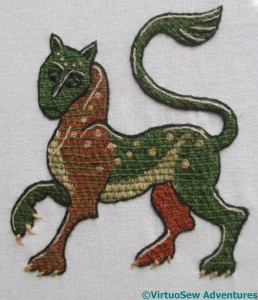
Spots The Eeyoropard
I went back to the dark green I used on Rusty, and used the same creamy yellow for the highlights. I don’t think I put in quite the same highlight twiddles as Tanya put on hers, but I like him just the way he is.
Apparently the Leopard of the medieval bestiary is a gentle creature – in spite of the fearsome claws, and according to Tanya, they all look “terminally grumpy”. I was talking about this with my friend @Matheknitician a week or so back when she accosted me at the MathsJam weekend, saying she was desperate to know what I was going to do with Rusty, and a day later she sent me a message suggesting that we should call Spots an Eeyoropard.
So, ladies and gentlemen, – Spots the Eeyoropard! Please be nice to him – he’s rather shy..

Dilemma
Now, you may recall from when I began the first one that there are to be two Crests, one for each panel, balancing each other. Furthermore, since there will be a gauze overlay, everything has to have the visual strength to show through it.
I don’t think that this silver thread has enough force or shine. Even with a fairly strong background using my Cloud Filling variation, to throw it into relief, it will simply disappear.
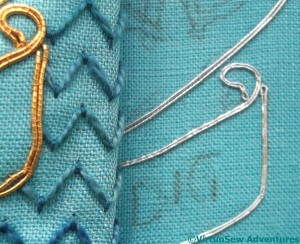
Auditions
So I have been experimenting. The edge of the shield, the top of the scroll, and the bottom of the scroll, all use different threads.
All of them are equally insipid in comparison with the gold. I’m afraid that if I use any of these threads for the panel, I will end up with an unbalanced overall appearance with one corner panel seeming very faded in comparison with the other.
I hope to find a more suitable thread at the Harrogate Knitting and Stitching Show this week. Or alternatively – more of the gold so I can do a second gold one!
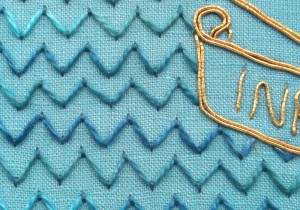
Detail Of Crest
The Cloud Filling Stitch variation that creates the ripple effect is fairly easy to do, and once I had decided to get working on it, finishing the first panel really ripped along.
As you see, I’ve not been too pernickety about spacing. It would have been possible, but it wouldn’t have been in keeping with the original inspiration, besides being utterly maddening to achieve.
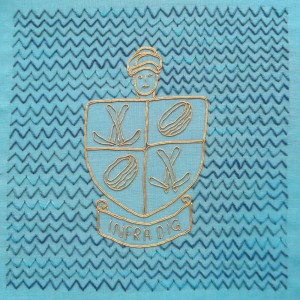
Finished First Crest
I began by working each row individually, first the short stitches and then threading the pearl cotton, but I soon found that it was much quicker to do several rows of the holding stitches, and then threading the pearl cotton through them.
So here it is, done. The other crest panel, when I get to it, will be in silver, with the same background. I need to get the other piece of fabric onto the frame and get ready, because it is good to have at least one project in which I know exactly what I want to do.
There is one question that remains to be solved – how will I edge each panel? I’ve been thinking about lucetting, crochet, or kumihimo. I have a feeling that a lot of experimentation lies in my future.
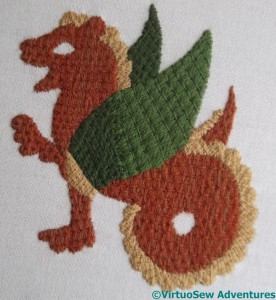
First Layer Completed
I did comment that the laid and couched work romps along, and once I got going, it really didn’t take long at all to finish the first layer.
In the interests of being sure of having enough thread to complete the Dragon, I used two shades of rust-coloured wool for his body. The underlayer of surface satin stitch is worked using two strands – making it possible to blend the threads – while the couching stitches are worked using a single strand.
Looking once more at Tanya’s Dragon on the Flickr Group, I realise that I’ve not quite followed her stitching angle in all places. but I’m very happy with how the first layer turned out.
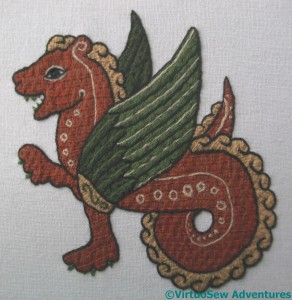
Detail Added
Once the first layer is done, there are details to be added.
And my goodness, what details!
There was a slight false start, because the creamy-white was too light, the wrong texture, and simply looked wrong.
Since the details are worked in split stitch, the necessary unpicking was a severe trial. However, the combination of a pair of tweezers and my brand new embroidery scissors from Ernest Wright and Sons Ltd (bought when I heard of them following a BBC article) made it as easy as it could be (still not very easy, though!).
I finally picked a creamy shade, lighter than pale yellow I used for his crest, but in the same family. It turned out really well, and even his green teeth don’t detract from his charm. He looks a very genial fellow, and I’ve named him Rusty.
I’ve been tagged in a round the world blog hop by Penny of ArtJourney, and while this post is a lot more “abstract” than my usual posts, it is always interesting to think about your own work in a different way. So thank you Penny, for giving me the opportunity!
1. What am I working on?
Er.. How long have you got? My long term project is the Dreams of Amarna, but at the moment I’m also following the Opus Anglicanum Stitch A Long, and now the weather is closing in, I will soon be back to the Crazy Canvaswork Cushion. That doesn’t include, of course, random little projects that I pick up and put down occasionally, or new techniques I try, but don’t find an immediate use for..
-
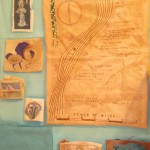
-
Rough Layout of the first panel
-
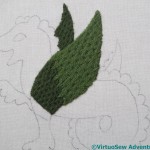
-
Wings In Laidwork
-
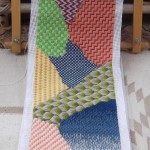
-
Two Thirds Done
2. How does my work differ from others of its genre?
I tend not to stick to a single type of embroidery, so there is a lot of cross-fertilisation between the styles of embroidery I use, and the way in which I use them. However, unlike a lot of similarly eclectic embroiderers, I rarely work anything truly abstract: there’s usually a story somewhere at the back of any piece I work. Two more long term projects I have plans for when Dreams of Amarna is done are panels relating to The Golden Fleece and The Conversion of Placidus. In fact, the Conversion of Placidus is bubbling at the back of my mind at the moment; I had a tour of Flag Fan with Francis Pryor a couple of weeks ago (fabulous, by the way, for anyone with any interest in prehistory!), and I’m desperate to include the kingfisher I saw there…
-
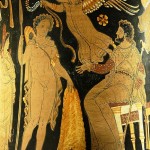
-
Jason bringing the Fleece to Pelias. Photo by Jastrow (2006) Public Domain Licence
-

-
Pisanello “Vision of St. Eustace” in The National Gallery, London
3. Why do I write/create what I do?
Because I love it. Embroidery is the medium in which I choose to respond to stories, ideas – or domestic opportunities. Many of my “non-literary” projects are worked with our house in mind – like the Firescreen, the chair seats, or the Finnish table runner.
-
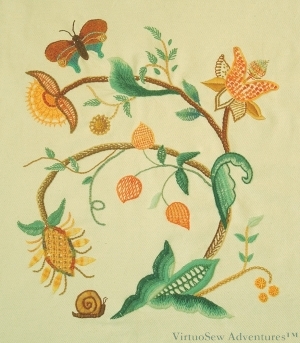
-
Jacobean Style Fire Screen
-
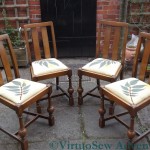
-
Finished Chairs
-
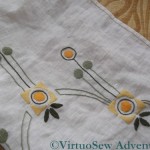
-
Table Runner Hemmed
4. How does my writing/creating process work?
It varies very much with the project in question. For the Dreams of Amarna, I have read and re-read the book “Nefertiti Lived Here” by Mary Chubb, I have visited the Egypt Exploration Society and the Petrie Museum, the Treasures of Tutankhamun exhibition and Discovering Tutankhamun at the Ashmolean and I have taken a course in working with metal threads. In fact, the idea was bubbling in the back of my mind for ten years before I even set a stitch!
In contrast, projects like the Elephant Doorstop, the Stones of Venice Footstool, or the Knot Garden are much more improvisatory!
-
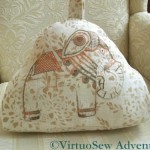
-
Finished Doorstop
-
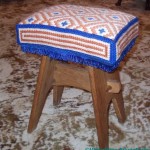
-
Finished Footstool
-
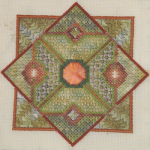
-
The Canvaswork Knot Garden
5. Tag – You’re It!
Of course, if I don’t tag someone, the Blog Tour would come to an abrupt halt… So, ladies – Tag, you’re It!
- Janice, who blogs at Dancing With Sunflowers, was one of the first people to encourage me to start to a blog, and to welcome me to the world of blogging. She crafts thoughtfully using a range of techniques, many of which I know I wouldn’t be good at, so I have the greatest admiration for her.
- Jules has recently started a new blog, Needle and Pen, since she felt that her earlier blog no longer allowed space for her changing interests in craft and art. I’m going to be very interested to follow the development of her new adventure.
The goldwork on the Crest for the Dig went rather quickly, and I found myself running straight into a brick wall. I narrowed my background choices down to two, and then stopped. I’ve even extended the patches of trial background, and propped the frame up to stare at.
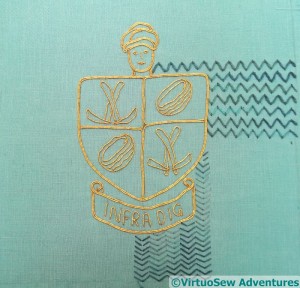
Two Background Choices
The arrowhead stitches create a subtle effect; patchy ripples, almost here-and-then-gone-again. Rather like Amarna, in fact – it’s thought the city was inhabited for less than thirty years.
On the other hand, the pearl cotton cloud stitch variation is more reminiscent of the rippling paint pattern that originally inspired me. The variegated thread helps to stop the background pattern from being too solid and monolithic.
Choices, choices….
In fact I took the frame to my parents’ house, last time I visited, and said plaintively “Help!”
We stared at it, talked about it, and finally decided that the pearl cotton variation on Cloud Filling Stitch is the way to go. It’s more in keeping with the idea of the doodle that inspired this design, the thread is closer in scale to the scale of the gold thread, and it’s also a better reflection of the ripple pattern I want to bring to mind.
I’m also considering how I’m going to edge the panel of stitching. At the moment, my ideas include lucetted cord or a flat kumihimo braid. The lucetted braid might be too narrow, but on the other hand I’ve only ever done one piece of kumihimo braid, so that would be rather a leap into the unknown!
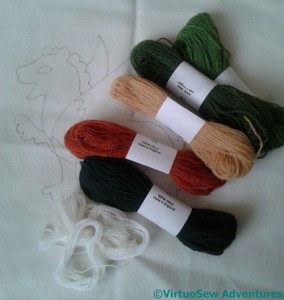
Thread For Dragon StitchALong
Do I really need another project to fit in, I wonder?
Well, yes, I think I do. Over on her blog, Opus Anglicanum, Tanya Bentham is running a medieval stitchalong, and quite simply, when she showed us a picture of the dragon she’d designed for us, I fell head over heels in love. He’s absolutely adorable, and I really didn’t care that I’m running short of time in any one week to do anything at all!
I decided not to buy a kit, since I have more wool thread than I know what to do with (remember my stash-busting canvaswork?), but I did buy some of the wool fabric Tanya suggested, and then rifled through my stash. Most of the wool is Appletons, but the creamy-white for highlights is a remnant of something rather smoother and silkier.
Maybe I’ll make some progress with the stash-busting, after all!
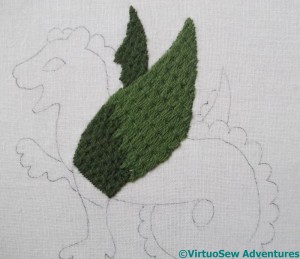
Wings In Laidwork
As it happens, I’m trailing slightly behind the stitchalong – and my blog is trailing behind my progress, because I’ve been enjoying stitching too much to stop and write about it.
The “colouring in” element of the design is worked in laid and couched work, which consists of three layers, in modern terms – surface satin stitch, with long couching stitches at right angles, which then in turn are tied down at intervals. Furthermore, it fairly romps along, which makes a lovely change after all that painstaking or nué earlier in the year!
There are several people taking part in the the stitchalong, not all of them bloggers, so Sue set up a Flickr group so that we could encourage one another..































